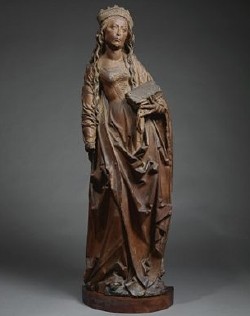I don’t think Jeff Koons did himself any favors by agreeing to be interviewed by The New York Times for yesterday’s Arts & Leisure section (here), did you?
 He agreed to talk, the Times said, partly because he is controversially curating Skin Fruit, the show at the New Museum drawn from the collection of Dakis Joannou, a trustee. And he agreed to discuss his own collecting, a topic many people have been wondering about for years — partly because he’s been buying Old Masters and 19th Century works, rather than contemporary. He paid $6.3 million at Sotheby’s for Tilman Riemenschneider’s beautiful limewood carving of St. Catherine, circa 1505, at right, for example. He also purchased a nude by Courbet, 1886, at Sotheby’s for $3.2 million, which he lent to the Metropolitan Museum’s 2008 Courbet exhibition.
He agreed to talk, the Times said, partly because he is controversially curating Skin Fruit, the show at the New Museum drawn from the collection of Dakis Joannou, a trustee. And he agreed to discuss his own collecting, a topic many people have been wondering about for years — partly because he’s been buying Old Masters and 19th Century works, rather than contemporary. He paid $6.3 million at Sotheby’s for Tilman Riemenschneider’s beautiful limewood carving of St. Catherine, circa 1505, at right, for example. He also purchased a nude by Courbet, 1886, at Sotheby’s for $3.2 million, which he lent to the Metropolitan Museum’s 2008 Courbet exhibition.
In April 2008, Apollo magazine wrote:
…there is something very encouraging about this unexpected link between an Old and a New Master in an age when contemporary art has become a lifestyle statement that has more to do with fashionable interior decoration and the luxury-goods market than it does with the history of art.
But Koons seems to have trouble articulating the connection. Asked what drew him to a different Courbet, of a bull, for which he paid $2.5 million, ” ‘I like this type work,’ he said simply about the Courbet, then pointed to a brown patch on the bull’s fur…” He also likes a stomach crease in a Manet nude and a spilled chamber pot in a Knüpfer Venus.
About the only coherent thing he said, imho, was the kicker:
When I view the world, I don’t think of my own work. I think of my hope that, through art, people can get a sense of the type of invisible fabric that holds us all together, that holds the world together.
Hardly a new thought.
No wonder Randy Kennedy, the writer, decided to quote Koons at random, saying things like art “lets you kind of control physiology and the secretions that take place within the body.” Another time, Kennedy cites Calvin Tomkins, who in a 2007 profile of Koons wrote:
…it is possible to argue that no real connection exists between Koons’s work and what he says about it.
Bottom line: Koons, as uncommunicative as ever, had it both ways. The article’s main beneficiary is the New Museum, which received more publicity for a troubled exhibition. Score another point for the PR machine.
But Koons has been busy, and not just directing the assistants mentioned in the article. According to today’s New York Post, he just agreed to pay $20 million for a 10,000 sq. ft. “palatial” townhouse at 13 East 67th St. — “the longtime home of the late Barbara “Bobo” Rockefeller, who turned its lavish interior — with 19-foot ceilings, a squash court and a pool — into a must-visit stop on New York’s society circuit for decades.” It has since fallen into disrepair, the Post says, leaving Koons lots of work to do.
